Winter barley variety LG Capitol has withstood one of the wettest seasons on record as well as any winter wheat and looks full of promise heading towards harvest 2024, says Shropshire farmer & contractor, Rob Bebbington.
Fieldfare Farmers covers some 365 ha (900 acres) for a range of clients across Cheshire, Shropshire, and north Wales. It has a varied rotation, split roughly 50:50 between autumn cereals and spring cropping, including potatoes, forage maize, oilseed rape, winter wheat and winter barley.
Winter barley is grown primarily as an early entry for oilseed rape, and this year, Mr Bebbington’s whole barley area (28 ha) is down to LG Capitol, grown for the first time on the recommendation of seed supplier and grain buyer, Wynnstay.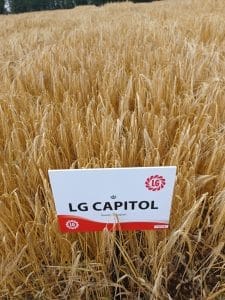
“Historically, 20 years ago, winter barley always looked a bit disappointing after a wet, cold winter, whereas with the improvements in genetics we’ve seen in recent years, now it almost seems to withstand the conditions as well as any winter wheat,” says Mr Bebbington.
“Indeed, despite one of the wettest years we’ve ever had, LG Capitol has stood up to the wet autumn and spring, and looks incredible! I can’t wait to see how it performs going into the shed this harvest.”
This year’s LG Capitol was sown on 26 September at a seed rate of 165 kg/ha, after forage maize. Land was ploughed, power harrowed and drilled in good time last autumn, allowing crops just enough time to establish before the winter set in, he says.
In total, the LG Capitol received 165 kg N/ha (applied as 26N 31SO3 and granulated urea), two fungicides based on bixafen, Fluopyram + prothioconazole and fluxapyroxad + Mefentrifluconazole, plus a mepiquat-based growth regulator, and foliar manganese.
Mr Bebbington says winter barley yields typically average around 7.6-8 t/ha (3.1-3.2 t/acre), but looking at the condition of the LG Capitol approaching harvest, he is cautiously optimistic that this year’s crop will at least match, if not exceed, that level.
The crop will be followed by oilseed rape. “We still like growing oilseed rape; it fits in well with our rotation and gives us a good spread of cropping, with winter barley providing an excellent early entry. Fingers crossed we haven’t suffered too badly with cabbage stem flea beetle.”
Looking ahead to the coming autumn, Mr Bebbington says end user requirements remain a key driver of varietal choices, so will again influence final decisions.
“But at the same time, we like LG Capitol, and don’t feel a need to change from it.”
LG Capitol
- –> Highest yielding 2-row winter barley for the east & north
- –> Yield comparable with hybrid varieties
- –> Strong disease resistance – notably brown rust, Rhynchosporium & mildew
- –> Good specific weight & screenings
Limagrain sister varieties; LG Caravelle & LG Capitol, dominate the 2-row feed winter barley AHDB 2024/25 Recommended List.

Mark Ullyott
LG Caravelle performed very well last harvest on the Yorkshire Wolds, for Mark Ullyott of Langtoft Grange Farm near Driffield, and he was extremely pleased with yields between 8.5-9.5 t/ha.
“We have grown seed crops of barley for over 10 years, and LG Caravelle must be the best we have seen,” he says.
“It is always interesting growing a new variety for the first time to see how it performs, and we are very pleased with LG Caravelle and will grow it again. If we could, we would put all of our acreage down to the variety,” says Mark.
Ron comments ‘LG Capitol Backs up Successful Genetics’
“LG Capitol backs up the successful genetics of LG Caravelle, in that it is a sister line selected from the same initial cross.
LG Capitol has shown similar very high yield potential, sitting on 106% for the UK and 107% in the east, and importantly, it has shown this high consistency of performance over regions and seasons.
This trait, combined with the desirable agronomic attributes of good standing, a good disease resistance profile and good grain quality, makes it a great addition to the new RL and it will be of interest to all barley growers.”
LG’s Summer Demo DaysLG has a range of summer open days across the UK, to present their demo trials, alongside Limagrain’s technical experts who will be providing all the latest information on new & existing varieties.
As well as the LG experts, each event will feature industry experts from within the agricultural sector, providing technical information on an array of topics such as fertiliser & micronutrients, agrochemicals, SFI’s and more. On top of this, we will again be running the Moisture Meter Clinic, which has been a farmer favourite in past years.
LG’s Summer Demos will have a wide assortment of winter wheat varieties to show, including Limagrain’s No.1 highest yielding variety; LG Beowulf, and a taste of Limagrain’s up and coming RL Candidates and NL2 offerings.
Alongside this, they will also be displaying commercial competitor varieties, with both untreated and treated plots.
Rothwell and Woolpit will be showing all varieties in the Limagrain winter barley portfolio, including the 2 highest yielding; LG Caravelle & LG Capitol, plus exciting new BYDV tolerant RL Candidate, LG Carpenter.
Register now…
—-> Tues 9th July – Rothwell, Lincolnshire
—-> Weds 17th July – Perth, Perthshire
BASIS/NRoSO points will be available for each Demo Day.
If you are thinking of growing an LG variety, have an interest in learning more, or have any questions for our experts, Register Now for one of our Demo Days.
Highest yielding Recommended varieties on show at CerealsPlant breeders Limagrain UK will showcase their impressive portfolio of varieties across crop sectors at Cereals 2024.
After several years absence from Cereals, the breeders have returned to the Event on the back of their resounding success on the 2024/2025 AHDB Recommended List.
“Producing the highest yielding varieties, backed up with desirable agronomic characteristics is an exceptional achievement for any breeder. What’s more, these varieties have proven to be robust and consistent performers across seasons and regions,” explains Ron Granger, Limagrain’s arable technical manager.
 Visit stand 606 to find out more about the highest yielding winter wheat LG Beowulf, LG Caravelle the highest yielding 2-row winter barley and the highest gross output oilseed rape varieties LG Armada, LG Adeline and LG Academic.
Visit stand 606 to find out more about the highest yielding winter wheat LG Beowulf, LG Caravelle the highest yielding 2-row winter barley and the highest gross output oilseed rape varieties LG Armada, LG Adeline and LG Academic.
There will also be experts on hand to discuss Limagrain’s very diverse portfolio, including maize, forage crops and SFI options as well as an opportunity to enter a prize draw to win free seed.
“We are here to listen and share our expertise on how to get the very best out of Limagrain genetics, and the Cereals Event gives us the opportunity to do this directly with the farming community we serve,” he says.
Visit LG on stand 606, buy tickets here
Limagrain Upgrades Malting Barley Laboratory at UK Head QuartersOur malting barley laboratory at Rothwell in Lincolnshire has been upgraded to increase testing capability for the early screening of new varieties, from 1000 to 4000 samples a year, for both the UK and European markets.
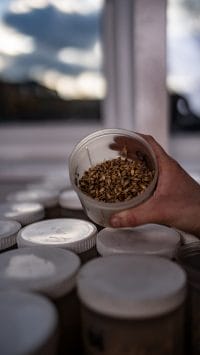
“This will allow us to use the data generated more efficiently to enable more accurate genomic selection, to better predict the malting potential and quality of the next generation of malting barleys,” says Sophie Buon, barley breeder.
“This new approach will test varieties under different micro-malting regimes, that require less water and less steeping – and in response to end user requirements, do this in the most carbon neutral way possible.”
“We hope that the new facility will encourage end-users to visit and see for themselves, the extensive work that we are doing to breed new and exciting malting barley varieties, that meet all of today and tomorrows market requirements.”

Plant breeder Limagrain’s winter wheat LG Beowulf and 2-row winter barley LG Caravelle, are the highest yielding varieties to join the 2024/25 AHDB Recommended List.
LG Armada also takes lead position as the highest yielding oilseed rape variety on the Recommended List for the UK, whilst LG Adeline takes pole position for oilseed rape in the North.
In addition, high yielding maize variety Saxon tops the 2024 BSPB Forage Maize Descriptive List for ME yield (‘000s MJ/ha).
This means that LG now offer the highest yielding varieties in; winter wheat, 2 row winter barley, OSR and maize*.

“This is an exceptional achievement for any breeder,” explains Ron Granger, Limagrain’s arable technical manager.
“Last year saw our winter wheat and winter barley varieties take pole positions across the RL. We have built on this success for a second year running, producing higher yielding varieties, backed up with desirable agronomic characteristics, securing high yield performance on farm. What’s more, these varieties have proven to be robust and consistent performers across seasons and regions.”
Highest yielding winter wheat
Group 4 hard wheat LG Beowulf yields 106% across the UK and shows the same consistency of performance across all regions: east (106%), west (106%) and the north (107%) – an outstanding achievement for any variety.
 LG Beowulf has produced these exceptionally high yields consistently in National List and RL trials over regions and seasons, in both the unusually dry summer of 2022 as well as the exceptionally wet summer of 2023. Alongside these yields, it offers a good grain quality, with a spec weight of 78.3 kg/hl.
LG Beowulf has produced these exceptionally high yields consistently in National List and RL trials over regions and seasons, in both the unusually dry summer of 2022 as well as the exceptionally wet summer of 2023. Alongside these yields, it offers a good grain quality, with a spec weight of 78.3 kg/hl.
“LG Beowulf is much like LG Skyscraper; it performs wherever you grow it,” he says. “It can be drilled early or late – providing growers with a wide drilling window, as a first or second wheat, on light or heavy land, and there are very few varieties that meet this criterion,” he says.
LG Beowulf yields are backed up by a set of strong agronomic characteristics, offering an excellent disease resistance profile with ratings of 9 for yellow rust, 6.7 for septoria, as well as orange wheat blossom midge (OWBM) resistance.
It has very stiff straw and is rated 8 for standing in untreated and PGR treated trials, which strongly contributes to its reliability on farm.
“In summary, LG Beowulf is a very high yielding, robust and versatile variety that comes at a time when growers are looking more than ever to maximise output, in order to maintain profit in times of increasing costs,” says Mr Granger.
Highest yielding winter barley
LG Caravelle is the highest yielding two-row winter barley for the second year running, since joining the Recommended List in 2023.
“Offering UK yields of 105.6%, LG Caravelle continues to dispel any misconception that two row barleys are lower yielding than hybrids. The variety certainly competes with the best yielding hybrid barleys, especially in the east,” says Mr Granger. “LG Caravelle is competitive in a black-grass situation, another characteristic that is normally associated with hybrids.” 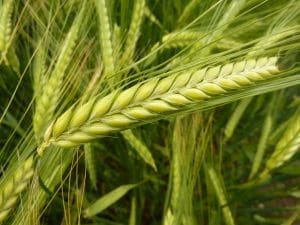
“LG Caravelle’s high yields are backed up by an excellent disease profile, reflected in its superb untreated performance, it is early maturing with stiff straw and good brackling resistance.”
“LG Caravelle also offers an exceptionally high specific weight for a winter barley, of 71.4 kg/hl combined with low screenings %,” he adds.
“Indeed, LG Caravelle possesses all of the key characteristics for a winter barley.”
LG Capitol is a two-row winter barley that joins the Recommended List this year and is a sister variety to LG Caravelle, offering similar yields and consistency of performance over seasons and regions. Its yields sit just 0.1% behind that of LG Caravelle, at 105.5%.
LG Capitol also combines a high specific weight and ripening, similar to KWS Tardis, with a solid disease resistance profile and good straw attributes.
Highest yielding OSR
The top three highest yielding oilseed rape varieties on the 2024/25 AHDB Recommended List all come from the Limagrain stable, offering exceptional consistency over regions and seasons.
LG Armada tops the UK and E/W List at 107%, LG Academic follows 1% behind at 106%, with LG Adeline taking pole position on the Northern List with an outstanding yield of 108.3%.
LG Armada is one of the next generation of versatile high yielding oilseed rape varieties, improving on the characteristic trait loaded-hybrids that growers have come to expect from Limagrain.
“‘Ambassador-like’ in its growth habit, LG Armada has strong autumn vigour, is robust, with good adaptability to all regions of the UK,” says Limagrain’s oilseeds product manager, Liam Wilkinson.
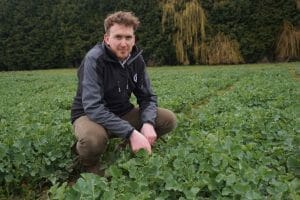 “LG Armada is the first of our seventh generation of hybrids, bringing new maintainer and restorer lines to our OSR portfolio. This effectively means we are bringing varieties to market offering a stacked portfolio of much improved stem health attributes, alongside the standard pod shatter, TuYV and RLM7 resistance traits.”
“LG Armada is the first of our seventh generation of hybrids, bringing new maintainer and restorer lines to our OSR portfolio. This effectively means we are bringing varieties to market offering a stacked portfolio of much improved stem health attributes, alongside the standard pod shatter, TuYV and RLM7 resistance traits.”
“We know stem health is key to driving consistent oilseed rape yields across farms and with these seventh-generation hybrids, we are seeing bigger stems and better rooting which also results in higher oil content,” he says.
Highest yielding maize
Limagrain’s maize variety, Saxon was added to the BSPB 2023 Forage Maize Descriptive List and has made the top of the list for 2024 for its ME yield of 225 (‘000s MJ/ha). It has dry matter yields of 19.1 t/ha, making it ideal for all uses, including anaerobic digestion.

“On the Descriptive List, Saxon yields 105% of the average and additionally is quite an early variety with an FAO of 180,” says Tim Richmond, Limagrain’s product manager for maize.
“Saxon combines superb early vigour with good standing power, making it perfectly suited for all mainstream maize sites.”
“LGAN has long been the watchword for maize varieties that deliver what really counts – high yields of high-quality feeds that sustain excellent milk yields. Saxon is one of the latest examples of the benefit of breeding varieties that deliver in the clamp.”
To learn more about how any of these varieties could perform on your farm, click the links below;
LG Maize
LG Winter Wheat
LG Winter Barley
LG OSR
- * Data: 2024/25 AHDB RL / *2-row winter barley. 2024 BSPB NIAB Forage Maize Descriptive List – First choice varieties for favourable sites by ME yield of fresh plant at harvest (‘000s MJ/ha)
Two row winter barley, LG Caravelle, joined the AHDB RL last year as a contender to match hybrid barley yields, and early harvest reports confirm that it has lived up to its promise.
Despite the challenging season, the variety has performed well on the Yorkshire Wolds. Mark Ullyott of Langtoft Grange Farm near Driffield, is really pleased with his seed crops of LG Caravelle, yielding between 8.5-9.5 t/ha.
“We have grown seed crops of barley for over 10 years, and LG Caravelle must be the best we have seen,” he says.
He grew two fields this year: one following vining peas and the other after potatoes. The crop following the vining peas was drilled on the 28th September at the standard seed rate of 300 seeds/m2. This field was ploughed, pressed & combination drilled.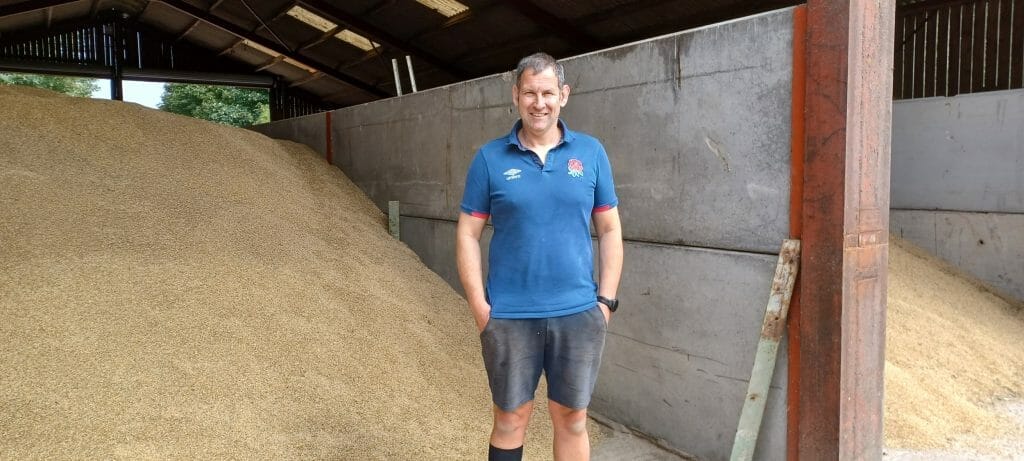
The field following the potatoes was min-tilled and went in a bit later, on the 23rd October, with a slightly higher seed rate of 350 seeds/m2, to compensate for the later drilling.
Both fields established well and looked pretty good. “We don’t have too much of a black-grass issue, so a pre-emergence application of flufenacet and diflufenican at 0.4 l/ha and some Avadex, pretty much tidied up any weeds,” explains Mark.
Disease-wise, the crop stayed clean with a standard fungicide programme, and received 160 kg of Liquid N32/ ha, which was reduced slightly due to the increased fertiliser costs at the time.
“It’s a fairly tall variety, so we used a ‘bottom-shortening’ PGR, chlormequat, but I think the crop would benefit from a ‘top shortener’ as well next time, just to reduce its height that bit more, although it’s important to note the straw strength was good and we didn’t have any lodging or brackling issues.”
“Both fields were ready to harvest by the third week of July, but the wet weather meant the field following the vining peas was ready first on the 31/7 but we had to hold on for another week for the second field, again due to the weather.”
“Despite this, the crop held its own, germ still looked good and bushel weight held up with no sprouting. The straw came off well; all of which goes for home use,” he adds.
“It is always interesting growing a new variety for the first time to see how it performs, and we are very pleased with LG Caravelle and will grow it again. If we could, we would put all of our acreage down to the variety,” says Mark.
LG Caravelle joined the 2023/24 Recommended List as the highest yielding two row winter barley.
“We launched the variety not just on the back of its high yields but with a confidence that the variety would deliver across a range of conditions,” says Ron Granger, Limagrain’s arable technical manager.
“The years running up to its recommendation were dry and the variety yielded exceptionally well, however this season has been much wetter but LG Caravelle has upheld its promise of consistency and delivered the yields – and that’s a very valuable attribute on farm.”
Ron explains LG Caravelle’s yield potential is backed up by its specific weight. “Specific weight is important no matter what, and LG Caravelle’s is very high at 71.8 kg/hl. It’s one of the best scores available and is only surpassed by KWS Cassia.”
LG Caravelle’s yield potential is also bolstered by its disease resistance profile, says Ron. “The variety has a 7 for mildew, a 6 for rhynchosporium and a 5 for net blotch,” he explains. “Although there’s no rating on the RL yet, our data indicates the variety scores a 7 against brown rust, which is high against this disease.”
The variety also has resistance to barley yellow mosaic virus, giving it all round disease resistance, he adds. “The culmination of this can be seen in its untreated yield.” “It has a very high untreated yield of 89%, which really gives growers security,” he adds.
Ron feels that growers who’ve been growing hybrids might be interested in returning to two-rows because of LG Caravelle’s performance. “Hybrids account for about 20-25% of the winter barley market but this could change. Plus, we’re currently testing to see if LG Caravelle could be suitable for more than just the feed market.”
“We’re seeing the next step in on-farm varietal security for farmers and these types are proving to be an option on-farm again.”
Fungicide programme:
Esfenvalerate 2.50%, was applied at growth stage 14.
6th May: T1 consisting of Cyprodinil 30.00%, Tribenuron-methyl 14.30%, Metsulfuron-methyl 14.30%, Florasulam 0.25%, Fluroxypyr 10.00%, Trinexapac-ethyl 25.00%, and Folpet.
6th June: T2 consisting of prothioconazole 25.00%, trifloxystrobin 8.80%, and prothioconazole 17.50%.
LG GatePost Newsletter – June 2023The June 2023 issue of LG GatePost is now available to download.
This edition features articles about our newest wheat addition to the 2023-24 AHDB Recommended List, LG Redwald, as well as LG Caravelle, our excellent 2-row winter feed barley.
You can read about and view our Live Panel event which was a round table discussion on Varieties, Soils and Policy with industry experts.
We discuss the new Sustainable Farming Incentives and the new ‘actions’ involved, with an article about why to consider establishing a legume fallow.
There is also information about our upcoming Demo Days and a link to register.

LG GatePost – June 2023
Over the last 10 years, breeders have made great progress in improving 2-row feed winter barley varieties. Newer varieties offer superior yield potential with better disease resistance and good grain quality attributes – desirable characteristics recognised by all feed barley growers.
LG Caravelle leads the way in this new world, as the highest yielding 2-row winter barley to join the 2023/24 AHDB Recommended List.
Bred by Limagrain, LG Caravelle dispels any misconception that 2-row barleys are lower yielding than hybrids, as it offers UK yields of 106% – which is as high as the present top yielding hybrids. Its performance in the east (109%) is exciting, with a significantly higher yield potential than any other variety; including hybrids – where it has a 3% advantage.
More importantly, the variety has shown a high consistency of performance across both regional and seasonal data sets.
These high yields are backed up by an excellent disease profile, reflected in LG Caravelle’s high untreated yields.The variety has a good rating of 7 for mildew, which can be a difficult disease to control in winter barley, as we saw last spring. Limagrain data suggests a 7 rating for brown rust – again this disease can be the yield robber in many seasons when not effectively controlled.
The variety has a respectable 6 rating for Rhynchosporium, a 5 for Net Blotch and is BaYMV resistant.
Agronomically, LG Caravelle is shorter strawed like LG Mountain, and offers both good lodging and brackling ratings with an earlier maturity (0).
LG Caravelle also offers an exceptionally high specific weight for a winter barley, at 71.8 kg/hl; one of the best available and only surpassed by the old favourite, KWS Cassia.
Early indications from AGRII black-grass competition trials in Cambridgeshire, suggests that LG Caravelle is competitive in a black-grass situation, offering high yields and black-grass ear reduction levels similar to that of hybrids.
Download the latest edition of LG GatePost here
LG Live Panel – Varieties, Soils & PolicyOn 21st March, LG’s Ron Granger and Tom Barker were joined by industry experts, Tim Parton (Farm Manager, Staffordshire) and Susan Twining (CLA Advisor) for a live Q&A round table discussion on Varieties, Soils & Policy.
Key Questions raised…
1. Do you still think yield is king? Are breeders, such as Limagrain, breeding varieties specifically for a regen system?
RON GRANGER: “Yield will always be important because farmers have to make an income. But the key issue going forward is around yield security, especially with our changing climate. For example, the capability of a plant to withstand spring droughts is now becoming an increasingly important factor.”
“Robust disease resistance also has a key part to play – we are currently seeing the fruition of stacking genes in both Septoria and rust resistances. Resistance to pests is also key.”
“Most growers have been adopting some form of regenerative practise for the last 5 years, so we are in a position where growers are able to tell us, as breeders, what they want from varieties to suit a regen system for the future.”
“Generally, varieties for regen have been chosen from the present AHDB RL – which is not a problem. However, as breeders, we can look at the germplasm in our programme and identify varieties that will better suit a direct drilling, wide-row situation.”
2. What type or size of crop rotation is likely to be needed to sustain regenerative farming? Do you use companion cropping?
TIM PARTON: “I try to extend my rotation as much as possible and split spring to winter cropping by 50:50, to allow for as much cover cropping as possible. It’s the cover cropping that is key to the system and this brings in the variety of plants above and roots below the soil.”
“Companion cropping is important, particularly in OSR, where I grow white, berseem and crimson clover in the crop, to take it through. Nature doesn’t monocrop and plant diversity is key.”
3. Should regen ag be certified?
SUSAN TWINING: “At the CLA , we have looked closely at this, and decided that it is not something that we would advocate for at this stage, if ever. Regen farming is about a set of principles which allows for flexibility, depending on the farming situation etc. In certifying this, it would become a tick box exercise – which makes it a completely different concept.”
“ELMS offer a good suite of options to reward farmers for good practise. We already have the Soils SFI, the IPM, and Nutrient Management SFI’s coming out later this year.”
You can watch the full version HERE
LG Denmark Study TourIn the spring, Limagrain took a group of UK growers to Denmark, to look at regenerative and conservation agricultural practices.
After two full days of visiting farms, agronomy companies and a plant breeder, there was some very interesting and surprising feedback:
GEORGE ATKINSON, LINCOLNSHIRE: “It’s been fascinating to see all the different farming systems, and also learn about Danish policies that contradict themselves. I was expecting to come and see the future, but some of the growers are where we were 15 to 20 years ago.”
AL BROOKS, HAMPSHIRE: “I came here with a preconceived idea that we were going to learn something from the Danes in terms of their view towards conservation and regenerative agriculture. I was stunned by the amount of red tape they are subjected to. They are constricted in the industry and don’t have the voice with government.”
TIM PARTON, STAFFORDSHIRE: “I think the government advisors in Denmark need to take a real hard look at what they are trying to achieve, and what their directives are. They are so restrictive; they are missing out on the big benefits they could be getting from regenerative and conservation agriculture. They need to help their farmers more, rather than restrict them.”
“Discovering that UK farming practice with regards to conservation agriculture or regen is ahead of Denmark, was a surprise to many on the trip, and a real positive take home message for the UK.
It’s very noticeable that plant breeding is paramount to the future direction of agriculture, as practices move towards lower input and better disease resistances. Limagrain look forward to sharing what we do with growers from the UK and abroad,” says Tom Barker of Limagrain, who hosted the trip.
Download the latest edition of LG GatePost here
Survey reveals variety decisions driven by regional trials informationArable farmers favour local variety trials over national demonstrations when making crucial decisions about what varieties to grow next season, a survey by plant breeders Limagrain UK reveals.
The online questionnaire shows the overwhelming majority (86%) regard the information they gain from regional variety demonstrations as being more relatable than from national events.
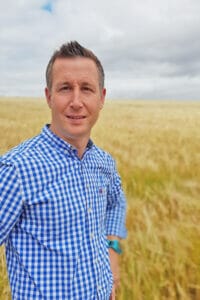
Tom Barker, Cereals and Pulses Product Manager
“This is mainly because local events offer the chance to see how new and existing varieties perform in local soils, climate, and disease situations,” comments Limagrain UK cereals and pulses product manager, Tom Barker.
“Indeed,43% of farmers responding to the survey have attended a regional event with variety trials in the past 12 months, compared with just 28% that have attended a national event, such as Cereals or Arable Scotland.”
“Around one quarter have taken part in an online trials webinar, such as those organised by AHDB, or NIAB TAG.”
“Three-quarters of growers are prepared to travel up to an hour or more to attend a regional variety trial, and alongside location and practical considerations, such as date and time, the quality of technical information on offer is a major factor influencing the decision to attend,” he says.
This shows growers value the opportunity to gather technical information on individual varieties, and how to grow them, he points out, although of particular interest is the ability to compare treated and untreated plots to see first hand how varietal characteristics stand up to seasonal pressures.
“Other areas of interest include; late versus early drilling comparisons, different methods of establishment, alternative fungicide programmes, and trace element/ micronutrient work.”
As might be expected, winter wheat varieties are generally of most interest, followed by winter barley, spring barley, oilseed rape, then a host of other minor crops.
“It is also clear from the survey that, while growers take information from a range of sources when making variety decisions, including independent bodies, breeders, agronomists, and seed merchants, the vast majority (93%) would confidently select a variety based on what they had seen or learned at a variety trial,” says Mr Barker.
“We organised the survey to find out what growers want from trials events, and how we can tailor them to their needs in the future.”
“It shows that growers base their varietal decision making on what they see or learn at demonstrations and trials, with regional events once again proving their worth as a place growers can go to gain knowledge and understanding of varieties.”
Summer Demo Days

Recognising the importance of local information when making variety choices, Limagrain UK hosts a series of events around the country every year.
This summer’s programme during June and July features five locations, from our milling wheat demonstration on the Essex coast near Maldon, up to the Perth winter wheat trials in central Scotland (see panel for details of all events).
Every demonstration will showcase a range of new and existing varieties, alongside five new Candidate wheat varieties currently going through Recommended List approval. These include two potential biscuit wheats, LG Arkle and LG Grendel, and two hard feed wheats, LG Beowulf – the highest yielding feed wheat Candidate – and LG Redrum.
Limagrain UK’s Rothwell site will also feature the new winter barley Candidate LG Capitol, plus the highest yielding two-row feed, LG Caravelle, which joined the RL this year.

































